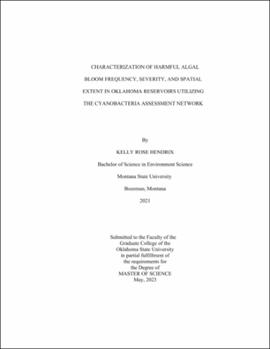| dc.contributor.advisor | Dzialowski, Andrew R. | |
| dc.contributor.author | Hendrix, Kelly Rose | |
| dc.date.accessioned | 2023-08-25T20:06:05Z | |
| dc.date.available | 2023-08-25T20:06:05Z | |
| dc.date.issued | 2023-05 | |
| dc.identifier.uri | https://hdl.handle.net/11244/338921 | |
| dc.description.abstract | Harmful algal blooms (HABs) pose significant threats to human health and the environment. Monitoring them in inland waterbodies is a challenging and costly task. Remote sensing technology is an increasingly useful tool in monitoring and managing HABs, providing timely information on their bloom dynamics. The Cyanobacteria Assessment Network (CyAN) was developed to provide a consistent and uniform program for HAB detection and characterization across the United States. CyAN utilizes the Ocean and Land Colour Imagers (OLCI) aboard Sentinel 3A and 3B to provide near daily imagery of the major waterbodies across the country. The objective of this study is to characterize the frequency, spatial extent, and severity of HABs in Oklahoma Reservoirs utilizing CyAN. Sixty nine waterbodies were selected for analysis. They include the largest lakes and reservoirs in Oklahoma. Frequency, spatial extent, and severity were assessed for trends over the six-year study period (2017-2022). Trend analysis was grouped into four bloom categories: high (>100,000 cells/ml), medium (20,000-100,000 cells/ml), low (<20,000 cells/ml), and total bloom. High, medium, and low-risk bloom thresholds are based off of the World Health Organizations risk of health impact thresholds. Total blooms represent any bloom level above sensor detection. The findings of this research indicate that statewide HABs are increasing in frequency over the study period for all bloom categories. The spatial extent of HABs is increasing statewide for all bloom risk categories. Bloom severity is increasing for multiple individual waterbodies. Significant differences in bloom frequency, severity, and spatial extent are observed between trophic states. The findings of this research highlight the potential of remote sensing as a valuable tool for HAB monitoring and provide insights for developing effective HAB management strategies. | |
| dc.format | application/pdf | |
| dc.language | en_US | |
| dc.rights | Copyright is held by the author who has granted the Oklahoma State University Library the non-exclusive right to share this material in its institutional repository. Contact Digital Library Services at lib-dls@okstate.edu or 405-744-9161 for the permission policy on the use, reproduction or distribution of this material. | |
| dc.title | Characterization of harmful algal bloom frequency, severity, and spatial extent in Oklahoma reservoirs utilizing the cyanobacteria assessment network | |
| dc.contributor.committeeMember | Stoodley, Scott | |
| dc.contributor.committeeMember | Rogers, Brad | |
| osu.filename | Hendrix_okstate_0664M_18113.pdf | |
| osu.accesstype | Open Access | |
| dc.type.genre | Thesis | |
| dc.type.material | Text | |
| dc.subject.keywords | CyAN | |
| dc.subject.keywords | cyanobacteria | |
| dc.subject.keywords | Oklahoma | |
| dc.subject.keywords | remote sensing | |
| thesis.degree.discipline | Environmental Science | |
| thesis.degree.grantor | Oklahoma State University | |
